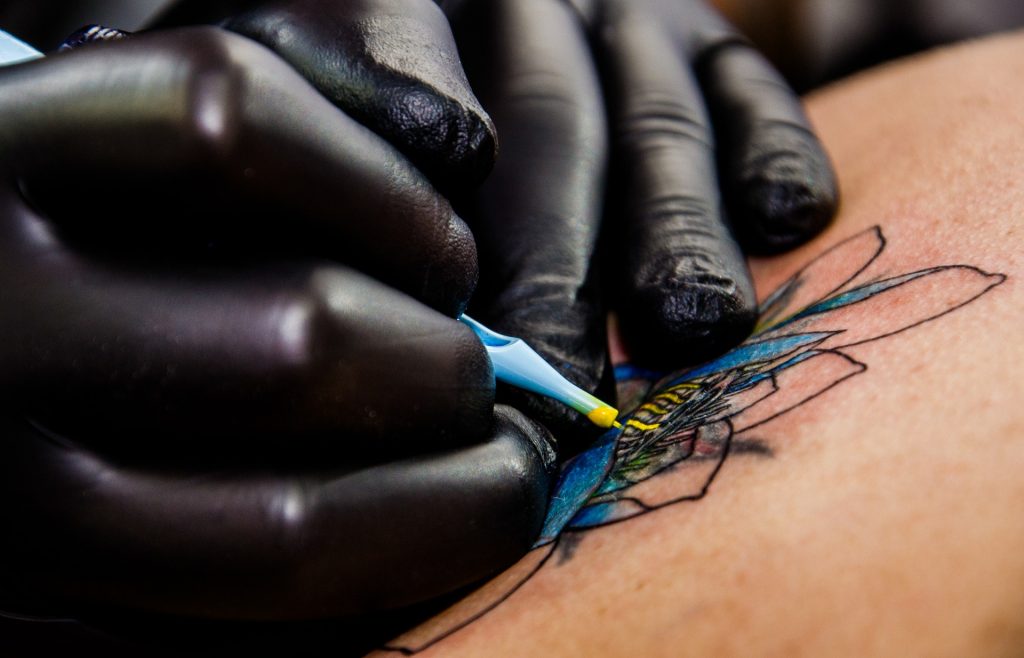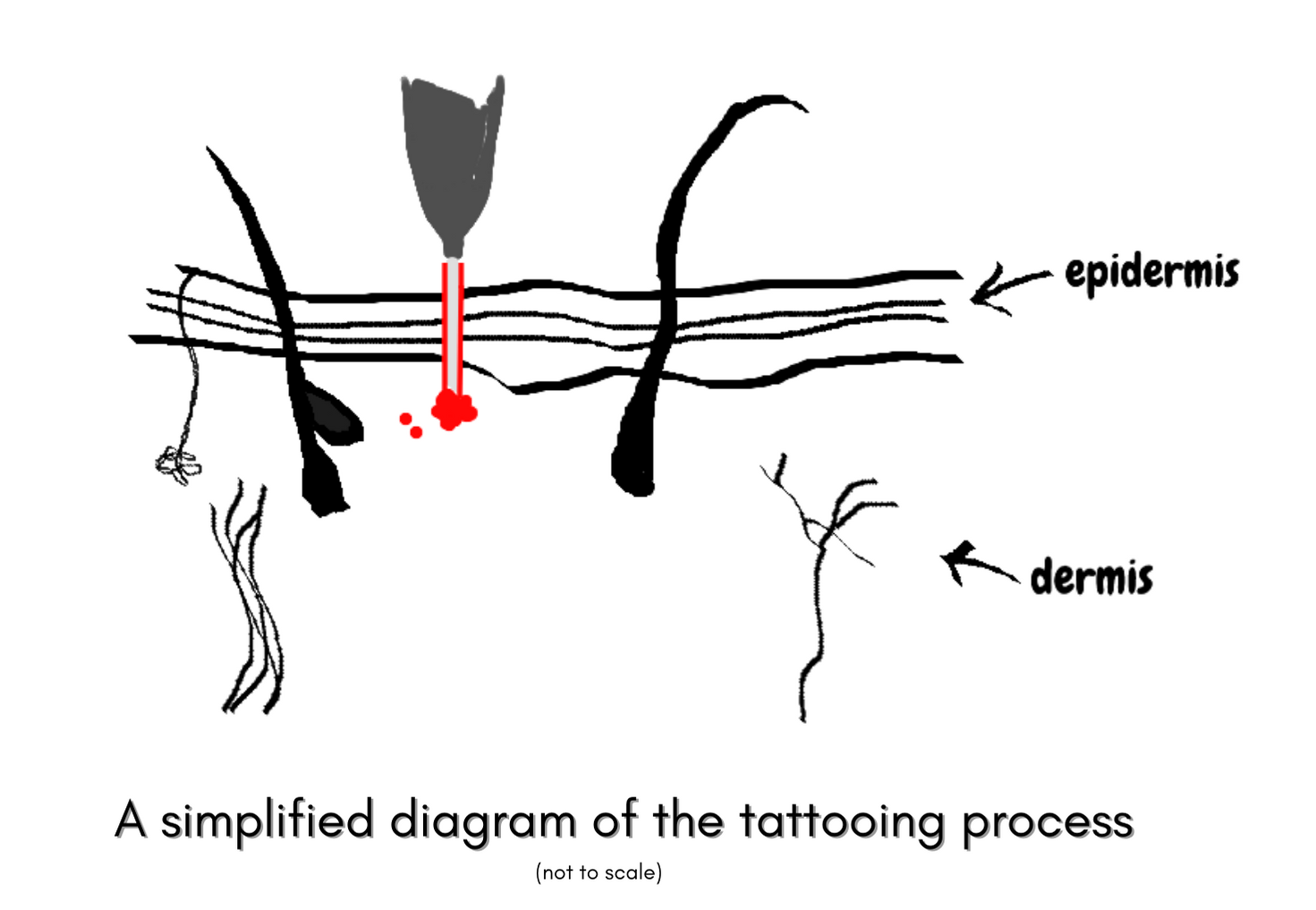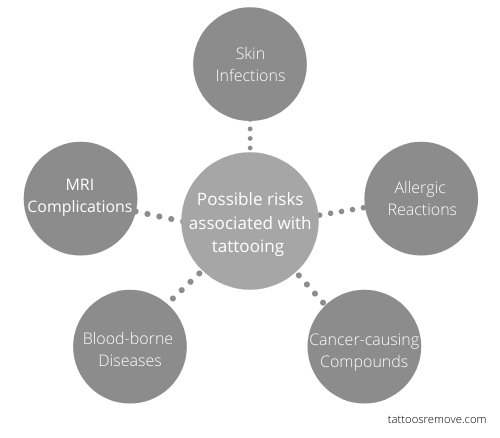Tattoo machines can puncture the skin at a speed of upto 3,000 times per minute. There’s a lot to know about tattoos before getting under the needle. This article will explain all the different things anyone needs to know before getting a tattoo.
–
Have you spent hours deciding on a tattoo? Should I get it on my arm or my ankle? Are hearts too cliched? Will I love it forever? What if I start hating it after ten years? (to which we say, tattoo removal is possible!). But have you taken a second yet to think about the process you’ll need to go through to reach that outcome? All the things that will be happening inside your body when the needle pokes into the skin to bring your tattoo alive? Or the fact that tattooing is not without risks. These things need your attention too. You’ll be spending as less as 5 mins to as long as hours under the needle. It is worth knowing what happens to the body during that time and after.
What happens when you get a tattoo?

Tattooing is basically permanent body art. These permanent marks and designs are made with inks, dyes, or pigments of different colors. There are several reasons connected to the natural functioning of the body that are responsible for the permanence of tattoos. The tattoo ink is not deposited on the skin surface. It is because the epidermis, the outermost layer of the skin, sheds 1 million skin cells per day. A tattoo carved on the epidermis would fade away in a few weeks. Instead, the tattoo ink is injected into the dermis layer of the skin. The dermis is made up of sweat glands, blood vessels, lymph vessels, collagen fibers, and much more. It is located right below the epidermis.

A tattoo artist uses needles to puncture the skin and inject the tattoo ink. Traditionally, different communities have used unique kinds of tools and techniques for tattooing. As mentioned above, Modern artists generally use tattoo machines that can puncture the skin at a speed of 50-3,000 times per minute. These machines have tiny needle points at the ends. There can be as few as three needles for outlining or as many as twenty-five needles for coloring. The needles are dipped in ink before being injected into the body.
As soon as the ink enters the skin, the body’s immune system comes into action. The needle piercing creates wounds that trigger an inflammatory process at the location. It is because the tattoo ink particles are seen as foreign elements which must be fought against. The needles may also pierce a few blood vessels and nerves and cause minor bleeding. Macrophages are special cells that are one of the first respondents on site. To free the body from this alien intrusion, they start eating up the pigment particles. While some of them end up in the lymph nodes, some of them remain dispersed in the dermis. Some ink particles also remain in the gel-like dermis matrix, while some are eaten by dermal cells called fibroblasts. The tattoo ink in the matrix, fibroblasts, and the floating macrophages is visible on the skin as the tattoo design. Some tattoo pigments also get deposited on the epidermis. These particles get removed with the shedding skin cells.
And yet, tattoos do fade over time. In its attempt to rid the body of these alien particles, the immune system continues to break the particles. UV rays can also add to the breakdown. Nonetheless, the tattoo will remain visible throughout a person’s life.
What does the tattooing process feel like?
Picturing a bunch of needles poking into the skin can send some people into overdrive. But the actual process may not be as painful as imagined. Everyone will experience some discomfort, but the level of pain will differ depending upon the individual tolerance level. People have explained their tattooing experiences differently – like a cat constantly scratching, a burning sensation, like bee stings, or just a dull pain. After the first few minutes, the body and mind will adjust to the uneasiness. The location of the tattoo also affects the amount of pain experienced. Body parts with more flesh or muscles are likely to hurt less compared to bony areas. Pain is also more likely in areas with a large number of nerve endings. Getting a tattoo on the forearm or calves is less painful than tattoos on the rib cage, underarms, or the head.
Given the trauma that the body experiences during this process, the nervous system releases adrenaline to reduce stress. There is also a release of endorphins, a natural painkiller. The endorphins try to increase feelings of pleasure to overcome the piercing pain of a tattoo needle. Tattooing can lead to a mix of emotions, both good and bad. For some, this experience is almost like a high. Many people get addicted to ink because of these overwhelming feelings.
Tattoo Healing Process
For the body, the tattoo is a new wound. The immune system takes the responsibility of healing this wound. The healing process can last for a few weeks. The dead skin cells will be discarded during this phase. The tattoo may initially look dull because of these dead cells sitting on the surface. By the end of the first or the second week, the tattoo may develop into scabs that peel off like a sunburn. This is just the dead cells flaking off and should not be a cause of alarm. Even if the tattoo is not peeling off on its own, it’s not necessarily an issue. The region may also appear a little swollen or/and red. Minor bleeding is also common. It is because the blood vessels also take time to heal.
What does this feel like?
For the first few weeks, the tattoo may itch. Despite the incessant irritation, it is important to make sure that the tattooed region is not scratched or forcefully peeled off. This can affect the tattoo colors. It may also feel a little sore and stingy for the first few days.
Some reactions may not be part of the normal healing process. Reactions take place near the tattoo and ease off in a few days. An infection lasts longer and may spread to different areas of the body. In such cases, it would be best to visit a doctor. Excessive swelling, redness, itching, rashes, ooze, or even scarring could be a sign that something is wrong.
Tattoo Health Risks
Tattoos and MRIs
Tattoos can be a cause of concern during MRI exams. Although rare, the magnetic fields can lead to swelling, redness, and even burns. Tattoos can also affect the quality of the MRI results. The FDA says that although it is a rare occasion (that may not last long), it is important to inform the doctor about any tattoos before the MRI.
Allergic Reaction to Tattoo
People with sensitive skin may suffer from an allergic reaction. This is because the ink is made of chemicals and other unnatural substances that can cause a reaction in the body. Red ink is one of the most common allergens.
HIV, Hepatitis B, Tetanus, MRSA, and other blood-borne diseases
Such diseases are a result of unsanitary practices at the tattoo parlor – the same needle being used for multiple people. The tattoo artist should always use new sterilized equipment.
Do tattoos cause Cancer?
Black tattoo ink has very high amounts of benzo(a)pyrene, which is a carcinogen. The breakdown of tattoo ink can also create cancer-causing compounds. Tattoos can also blind us to the early symptoms of skin cancer. Changes in melanoma (skin pigments) is generally one of the first symptoms. Large, dark tattoos can hide such changes from the naked eye. Tattooing should never be done on skin that has moles, discoloration, birthmarks, or other irregularities.
Tattoo Skin Infection
Some people may get keloids (scars), granulomas (small bumps around the tattoo), or other types of skin infection from the tattoo.

Getting a tattoo is a big decision. It is important to understand how the body reacts to the tattooing as well as the potential health risks it poses. Making an informed decision will ensure that you are well-prepared and always have peace of mind.




